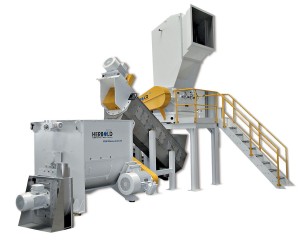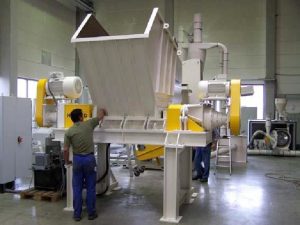Granulating, washing and drying

The NEUE HERBOLD range of size reduction machinery and separation technology was created for mixed plastics and scraps.
 Machinery can be standalone or as part of a plant and system:
Machinery can be standalone or as part of a plant and system:
- Granulators of all sizes and power
- Wet granulators
- Pulverisers
- Wash lines and plants
- Metal detection and separation facilities
- Drying systems – mechanical and thermal
 Granulators
Granulators
Our extensive range of granulators come in a variety of sizes, power and throughput capacities. From smallest sprue to the largest plastic lump, this range is built tough to ensure they are a match for any granulating project.
Operated as either press partner or centralised granulators for the effective size reduction of plastic and rubber materials including:
Bottles, Crates, Film, Pipe, Profile, Purge, Runners, Sheet, Skeletal Waste, Sprues, Start-up and Trim
 Granulator – LM Series
Granulator – LM Series
The LM series granulators operate at a minimal sound level and for mid-range applications. The granulator has easy access characteristics for quick cleaning, maintenance purpose and when doing material or product changes.
The LM series uses the true double cross cut knife configuration. It easily granulates film, containers, crates, automotive fascias, thin walled pipes, injection moulded and thermoformed parts, etc.
This series is ideal for size reduction of light and medium walled high volume plastic waste and can be manufactured with various types of rotors depending on the specific application.
 Granulator – SM Series
Granulator – SM Series
Granulators in the SM series are built to last, operate at a minimal sound level and are manufactured for mid to heavy range applications.
It has easy access characteristics for quick cleaning, maintenance purposes and when doing material or product changes.
The double cross cut and slanted rotating knives work in conjunction with stationary opposed slanted bed knives mounted in the granulator housing. This cutting geometry ensures a precise cutting gap, low energy consumption and reduced noise level.
Film, containers, crates, automotive bumpers, thick walled pipes, injection moulded and thermoformed parts, purging rubber and other heavy volume, thick walled applications.
 Pulverisers
Pulverisers
Our ZM series pulverisers are high- speed, fine grinding machines, designed for the processing of medium to hard density materials, along with brittle and high impact plastics (PE, PVC, and PC) that require final processing into powder form. Pulverisers material whilst optimising energy consumption and minimising operating costs.
Example materials include:
- Extruded pipe and profile granulate
- Pre-reduced sheets and edge trim
- Rigid film
- Amorphous and brittle products
From the following sectors:
Food industry, chemical industry and pharmaceutical industry.
 Hammer Mills
Hammer Mills
Hammer mills offer flexibility in their application range, from brittle plastics to electronic scrap, wood scrap, and organic insulation material. Their design is equipped with highly wear resistant cutting instruments.
Advantages:
- flexibility in their application range
- heavy duty design
- reduced space requirement due to compact design
- energy-saving size reduction
- extremely high throughput rates
- easy cleaning due to clam shell opening characteristics
- reduced down time for hammer replacement
 Separation Tank
Separation Tank
Easily separate plastics with various densities, including: film flakes, granulate from PET bottles and other rigid types of plastics. Depending on the application, floating particles are separated from other high density plastics. The standard separation tanks are manufactured from stainless steel 1.4301.
The material is fed into the tank directly or through a feeding screw. Specially designed separation plates and paddle rollers transport the material through the water quench. Excellent separation results are achieved, due to the long retention time of the material in the tank.
 Zig Zag Sifters
Zig Zag Sifters
The zig zag sifter is used for the separation of various types of materials for better quality, further processing or due to environmental reasons.
Function: the input material is moved through its own weight on the angled walls in an upward direction. At each individual bend on the sifter wall, the material passes through the air current to reach the next level. It then moves in a vertical direction to the air current to create a diagonal air flow. This causes the heavy material to separate itself from the lighter fraction and flow with the air current in an upward direction.
The degree of separation is dependent on the amount of stages utilized in the unit.
 Wash Lines
Wash Lines
The friction washer is mounted on a zinc-coated frame in inclined position. Drive is provided by a three-phase motor and an over dimensioned V-belt drive.
The rotor of the friction washer transports the material in upward direction. During the transport from the bottom to the top the material is intensively washed. Through the lid of the friction washer it is possible to add additional water straight into the material chamber. This improves the cleaning effect.
Fines, water and soaked paper are spun off and are pressed through the mesh of the screen cage. The water / fines mixture is gathering on the inner surface of the housing and is discharged through a discharge nozzle.
A number of maintenance openings in the housing wall enable easy cleaning and inspection of the machine. Rugged roller bearings assure a long durability. Adjustment bolds ensure easy centring of the entire bearing unit.
 Mechanical Dryers
Mechanical Dryers
The TM 1005 dryer is used as a down stream component of a wash system. It operates by surface drying material fractions primarily: film flakes, granulate from PET bottles and other rigid types of plastics.
The wet material fraction is fed into the upper hopper located on the end of the dryer housing. The mechanical dryer rotor transports the material through the dryer from the inlet side to the outlet port.
The angular degree of the rotor flights and the rotor speed are detrimental for the material duration time in the dryer and to achieve a low residual moisture content.
Since the material flow occurs from one side to the other, the material is transported with high speed and travels perpendicular to the flow which causes the material to be pushed toward the screen.
The screen allows the water to escape through its fine perforation.
The dryer is equipped with two individual cleansing wipers that slowly rotate around the total circumference of the screen cage to assist in screen cleaning and prevent screen blockage. The inner area of the dryer housing is simultaneously cleaned though the constant rotation of the cleaning wipers.
